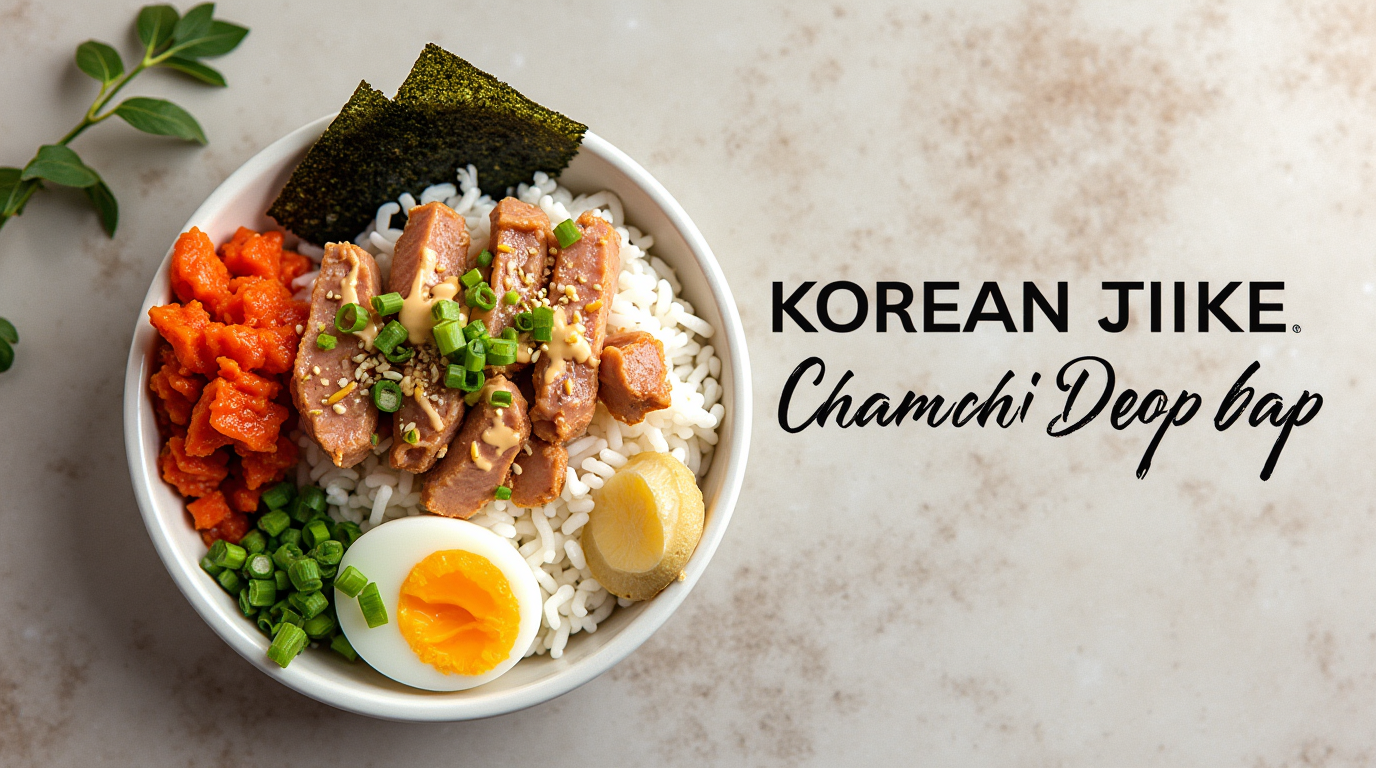Introduction to Korean Tuna Rice Bowl
Korean cuisine is renowned for its bold flavors, rich textures, and diverse use of fermented ingredients. Among the many quick and easy dishes enjoyed in Korea, Chamchi Deopbap (Korean Tuna Rice Bowl) stands out as a convenient and flavorful meal. This dish is a perfect example of how simple ingredients can come together to create a satisfying and nourishing meal.
Whether you are looking for Korean canned tuna recipes or simply a comforting bowl of rice with spicy and umami-rich toppings, this recipe is a must-try. It combines canned tuna with kimchi, seaweed, kewpie mayo, and a flavorful sauce to create a dish packed with umami goodness. If you are wondering how to use canned tuna beyond sandwiches or salads, this recipe will introduce you to an exciting and traditional Korean way to enjoy it.
Ingredients Needed
One of the best things about this tuna rice seaweed bowl is its versatility. You can easily customize it based on what you have at home.

Essential Ingredients:
- 1 cup cooked rice (short-grain or medium-grain rice is preferred)
- 1 can of Korean tuna (spicy or regular, drained)
- 1/4 cup kimchihaché
- 1 cuillère à soupe d'huile de sésame
- 1 teaspoon soy sauce
- 1 teaspoon gochujang (Korean red chili paste)
- 1 cuillère à café de sucre
- 1/2 teaspoon minced garlic
- 1/4 cup green onionshaché
- 1/4 cup roasted seaweed (gim), shredded or crumbled
- 1 teaspoon toasted sesame seeds
- 1 tablespoon Kewpie mayo (pour l'onctuosité)
- 1/2 teaspoon rice vinegar
- 1 soft-boiled egg (optional but recommended)
How to Make a Korean Tuna Rice Bowl
This dish is not only delicious but also incredibly easy to prepare, making it one of the best Korean quick meals for busy days. Follow these steps for a perfect rice and kimchi bowl with tuna.

Step 1: Prepare the Rice
Start by cooking your rice according to the package instructions. Short-grain or medium-grain rice is recommended for a sticky and chewy texture, which complements the toppings well.
Step 2: Prepare the Tuna Mixture
- Open the canned tuna and drain excess oil or water.
- In a bowl, mix the tuna with soy sauce, gochujang, sesame oil, sugar, and minced garlic.
- Add chopped kimchi to the tuna and mix well. Let it sit for a few minutes so the flavors can meld.
Step 3: Assemble the Bowl
- Place a generous scoop of warm rice into a bowl.
- Add the seasoned tuna mixture on top of the rice.
- Garnish with green onions, crumbled roasted seaweed, and toasted sesame seeds.
- Drizzle Kewpie mayo and rice vinegar over the top for added creaminess and tanginess.
- (Optional) Top the dish with a soft-boiled egg for extra richness.
Étape 4: Servir et Déguster
Mix everything together before eating to ensure that all the flavors are well-distributed. The combination of warm rice, spicy kimchi, umami-rich tuna, and creamy mayo creates an irresistible bite every time.
Why You Should Try This Recipe
1. A Perfect Way to Use Canned Tuna
If you’ve ever wondered how to use canned tuna in exciting ways, this recipe provides a simple yet delicious solution. Unlike Western-style tuna dishes, Korean-style tuna bowls elevate the flavor with fermented and spicy elements, making them unique and satisfying.
2. Quick and Easy Korean Meal
For those looking for Korean quick meals, this dish is an excellent choice. It requires minimal cooking and can be made in under 15 minutes, making it ideal for busy individuals or last-minute meal prep.
3. A Balanced and Nutritious Dish
Cette tuna rice seaweed bowl is packed with protein, healthy fats, and essential nutrients from tuna, kimchi, and seaweed. Kimchi, a staple in foods with kimchi, provides probiotics and aids digestion, making this dish both tasty and good for your gut health.
4. Customizable for Different Preferences
If you prefer a spicier version, add more gochujang or use spicy Korean tuna. If you like a more umami flavor, increase the soy sauce and sesame oil. You can also experiment with additional toppings like avocado or pickled radish.

Variations of the Korean Tuna Rice Bowl
1. Spicy Tuna Kimchi Rice Bowl
For an extra kick, use spicy Korean canned tuna and add more gochujang. Top with extra kimchi for a bold, fiery flavor.
2. Avocado Tuna Rice Bowl
Add sliced avocado for a creamy texture that complements the spicy and umami-rich flavors.
3. Cheese Tuna Rice Bowl
For a fusion twist, melt a slice of cheese over the tuna mixture. The melted cheese adds an unexpected richness that pairs surprisingly well with kimchi.
4. Vegan Tuna Rice Bowl
Replace canned tuna with mashed chickpeas or plant-based tuna alternatives. Use vegan mayo instead of Kewpie mayo to keep it plant-based.
FAQs About Korean Tuna Rice Bowl
1. Can I use regular canned tuna instead of Korean canned tuna?
Yes! If you don’t have Korean canned tuna, use regular canned tuna and mix it with soy sauce, sesame oil, and a bit of gochujang to recreate the flavors.
2. Is this recipe good for meal prep?
Absolutely! You can prepare the tuna mixture in advance and store it in the fridge for up to 2 days. When ready to eat, simply assemble the bowl with fresh rice and toppings.
3. Can I eat this dish cold?
While this dish is best enjoyed warm, it can also be served cold, especially during hot summer months.
4. What other toppings can I add?
Try adding roasted nuts, crispy fried onions, or a drizzle of hot sauce for extra flavor.
Conclusion
L' Korean Tuna Rice Bowl (Chamchi Deopbap) is an easy, quick, and satisfying meal that showcases the delicious versatility of tuna rice and seaweed. Whether you’re exploring meals with Kewpie mayo or searching for Korean canned tuna recipesce plat est un must-essayer.
Cette rice and kimchi bowl delivers balanced nutrition, bold flavors, and effortless preparation. Perfect for both beginners and experienced cooks, it provides a delightful way to enjoy foods with kimchi in a new and exciting way. Try this recipe today and experience the rich and satisfying flavors of Korean cuisine!


